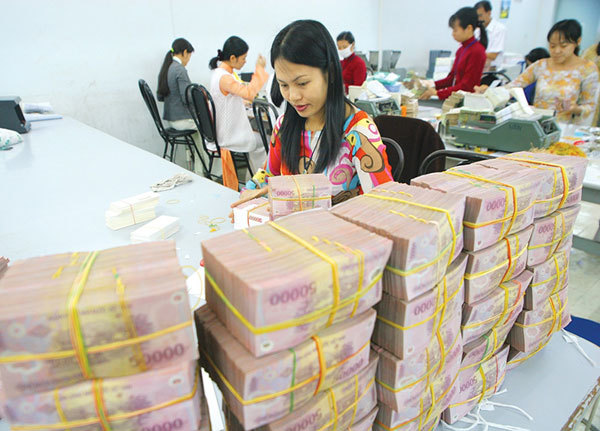 |
| In any case, public debt will not hit the limit of 65 per cent of GDP, said the Ministry of Finance. |
The General Statistics Office last week announced that in the first six months of 2021, there has been a surplus in the state budget of VND80.6 trillion ($3.5 billion) thanks to a rise in revenue created significantly by an increase in domestic business and production activities.
Specifically, total state budget revenues hit VND775 trillion ($33.69 billion). In which, domestic revenue totalled VND633.1 trillion ($27.52 billion), revenue from crude oil exports touched VND18.5 trillion ($804.34 million), and revenue export-import activities sat at VND122.8 trillion ($5.34 billion).
Meanwhile, the state budget spending was VND694.4 trillion ($30.2 billion), including recurrent expenditure of VND501 trillion ($21.78 billion), development investment of VND133.9 trillion ($5.82 billion), and interest rate payment of VND56.8 trillion ($2.47 billion).
According to a government report on Vietnam’s 2016-2020 official economic results just sent to the National Assembly Standing Committee (NASC) for consideration, in the 2026-2020 period, the economy’s total budget revenue hit VND6.89 quadrillion ($299.56 billion), completing the set target of VND6.864 quadrillion ($298.43 billion). This accounted for 25.2 per cent of GDP, higher than that of 23.6 per cent of GDP in the 2011-2015 period.
“The structure of state budget revenue became more sustainable, with the average ratio of revenue from domestic activities out of the total state coffers revenue rising from 68.7 per cent in the 2011-2015 period to 85.6 per cent in 2020,” said Minister of Planning and Investment Nguyen Chi Dung.
In addition, he said, the average ratio of revenue from crude oil exports and export-import activities reduced from 30 per cent in the 2011-2015 period to 14.1 per cent last year. Moreover, revenue from the local-level budget also improved, with a ratio in the total state budget revenue being 45 per cent in the 2016-2020 period, higher than that of 37.4 per cent in the 2011-2015 period.
The number of localities that could ensure their budget revenue and spending in the 2017-2020 period was 16, higher than the 13 in the 2011-2016 period.
Meanwhile, in the 2016-2020 period, the state budget expenditure hit VND7.6 quadrillion ($330.43 billion) or 28 per cent of GDP which was lower than 29.5 per cent of GDP in the 2011-2015 period.
Good control of spending
“One of the key reasons behind a decrease in spending, though expenditures for necessary activities were still ensured, was that the government had significantly reduced recurrent spending from a high rate of 64.9 per cent of the total state coffers spending in 2017 to below 64 per cent last year, given an annual 7 per cent rise in salary, pension, and allowances for those with meritorious services to the national revolution,” Minister Dung said.
“In addition, the government had well regulated the state budget within the estimates, while radically saving all revenues such as limiting the purchase of public cars and expensive things, and tightening expenditures for festivals, receptions, studies, surveys, and overseas business trips,” he added.
The government reported to the NASC that it was its good management and use of the state budget that had led to a reduction in state budget deficit to an average annual level of 3.3 per cent of GDP in the 2016-2019 period from an average annual level of 5.4 per cent in the 2011-2015 period.
However in 2020, the negative impacts of the COVID-19 crisis had caused a dent in the state budget revenue, while the country had to deploy numerous measures on deferral, reduction, and exemption of tax payment and many other budget receipts, and also had to increase spending for fighting against the pandemic and supporting enterprises and people.
The state coffers deficit last year stood at VND251.35 trillion ($10.9 billion), up VND16.55 trillion ($719.56 million) as compared to the initial estimates, and equivalent to 3.99 per cent of GDP.
“However, in the whole 2016-2020 period, the total state budget overspending averaged at 3.45 per cent of GDP, still lower than the target of 3.9 per cent set by the legislative body,” said the government report.
Ensuring safety for public debt
The positive budget situation has also meant that the country has been successful in ensuring debt safety in the 2016-2020 period, with an on-year reduction of public debt, contributing to making room for the government to implement its fiscal policy.
Specifically, the ratio of public debt in GDP decreased from 63.7 per cent in late 2016 to 55.2 per cent in late 2020. The government’s debt went down from 52.7 per cent of GDP in 2016 to 49.1 per cent in late last year, while foreign debt shrank from 49 per cent in 2017 to 47.2 per cent by the end of 2020.
In 2021, the government’s direct debt service will likely be about VND368.276 trillion (over $16 billion), and the public debt will exceed VND4 quadrillion ($173.91 billion), with an increasing debt service, though it is forecasted that by late 2021, the public debt will be about 46.1 per cent of GDP in case that the GDP will be reassessed, and be about 58.6 per cent of GDP in case that the GDP will not be reassessed.
In any scenario, whether reassessing or not reassessing GDP in 2021, the public debt will not hit the permissible limit of 65 per cent of GDP, said the Ministry of Finance. By 2025, the public debt is forecast to be 47.5 per cent of GDP if the GDP is reassessed, and 60.4 per cent of the GDP is reassessed.
According to The Economist’s Global Debt Clock, by late last week, Vietnam’s public debt in GDP remained almost the same as compared to the end of last year, sitting at 45.6 per cent, and per capita public debt was $1,039.67, while total public debt was almost $94.85 billion.
According to the International Monetary Fund (IMF), Vietnamese authorities’ effective fiscal management has helped to contain the public debt at around 55.8 per cent of GDP as at end-2020.
“The authorities are committed to prudent and effective public debt management strategy. These have been done through issuance of longer maturities of government bonds to finance fiscal deficits and debt repayment, leading to the lengthened average maturity of government bonds from 3.9 years in 2011 to 13.9 years in 2020,” the IMF stated in a recent report on Vietnam’s economy.
“The longer maturity profile of government bonds reflects the successful strategy of the authorities in diversifying bond maturities in the past 10 years, which has also been supported by the recent development of ample liquidity in the banking system, low interbank interest rate and investors’ confidence in the economic recovery.”
When it comes to public debt sustainability, the IMF said that under the baseline scenario, the publicly guaranteed debt (PPG)-to-GDP ratio is projected to increase by around 3 percentage points to 46.6 per cent of GDP in 2020, with privatisation receipts and a drawdown of government deposits partially compensating for the primary deficit (1 per cent per cent of GDP).
With Vietnam’s shortest maturities of bonds at five years, rollover risks are limited. PPG debt is projected at about 45 per cent of GDP by 2025, comfortably below the government ceiling of 65 per cent of GDP. The share of foreign currency-denominated debt is projected to decrease from 40 per cent of total debt in 2019 to about 30 per cent in 2025.
“A combined macro-fiscal shock in 2021 (incorporating the largest effect of individual shocks on all relevant variables) would increase PPG debt to about 52 per cent of GDP by 2025, which remains below Vietnam’s public debt ceiling of 65 per cent of GDP (although close to the authorities’ envisaged revised debt ceiling of 55 per cent of GDP),” read the IMF report.
Source: VIR

Vietnam to launch debt trading platform in third quarter
Experts called for Vietnam to soon provide a legal framework for the securitization of bad debts.

VAMC bad debts platform facilitates market options
The upcoming bad debt exchange platform from Vietnam Asset Management Company is being viewed as a promising legal intermediary which can effectively deal with sour loans,